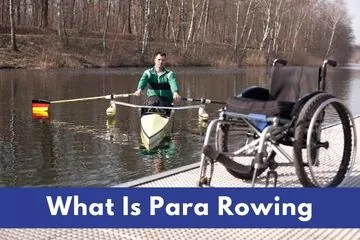
Hi friends! By now, I’m betting that you have either watched or at least heard of the Paralympics.
Formerly called the Special Olympics, these events are for competitors who have visual, physical, or intellectual impairment. The same is true with the para-rowing sport, which allows those with disabilities to compete in rowing events.
In today’s article, I want to discuss the details about para-rowing, what LTA rowing is, and the different classes that are available.
Similar to other Paralympic sports, para-rowing is open to both men and women who qualify. There are different events and classes, which makes it available to nearly everyone who qualifies.
I think that this subject is super exciting and inspiring.
Many people, myself included, find it easy to complain about every little thing. We tend to make excuses when things don’t work out the way we intended, but watching these young people give rowing all they’ve got is awe-inspiring. It makes me realize that I don’t have any real issues, just my excuses.
If you are ready for a fun ride about an exciting subject, keep reading! You won’t be disappointed!
How Is Para-Rowing Different from Regular Rowing?
Believe it or not, Para-Rowing goes back to 1913! The headmaster of Worchester College for the Blind in Great Britain encouraged his students to engage in every sport that the sighted participated in.
This headmaster believed that those with disabilities were every bit as competent as those without disabilities, and in many instances, he was correct. Even Helen Keller learned to row, swim, and ride a horse!
Formerly called adaptive rowing, you will now find these events at state and national championships called para-rowing.
Para-rowing events are held at the same venues, use the same docks, and even row the same distances (usually 2,000 meters) as regular rowing. Even the boats are the same, only adding a few safety features.
Perhaps the only difference between para-rowing and regular rowing is that para-rowing allows for mixed crews (males and females) while many other events have male-only and female-only crews.
If someone didn’t announce that the event you were about to see was a para-rowing event, you would probably never notice the difference!
Para-rowing was begun at the 2008 games in Being, China. There are currently 12 nations competing in these events, with more national championships being added in the near future.
- Click here to Learn About Adapting Rowing for Masters Rowers
What Disabilities Qualify for the Paralympics?
The classification system varies by sport and is controlled by the International Federation overseeing each sport.
For the Paralympics, there are 10 eligible impairments. An athlete needs only one of these 10 to qualify, but having more than one is not uncommon.
The 10 qualifying impairments are:
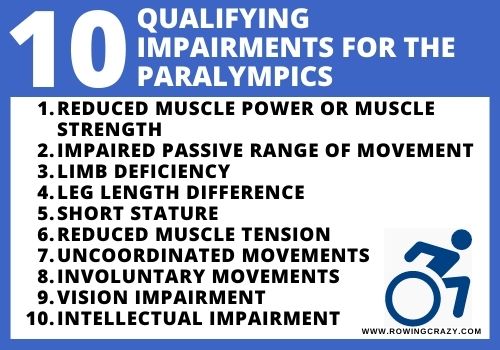
- Reduced muscle power or muscle strength
- Impaired passive range of movement
- Limb deficiency
- Leg length difference
- Short stature
- Reduced muscle tension
- Uncoordinated movements
- Involuntary movements
- Vision impairment
- Intellectual impairment
Since each sport has different qualifications, applicants may qualify for one sport but not for another. Applicants must give their best effort as they will be screened for the three sport classes.
What Are the Paralympic Rowing Rules?
There are 6 types of eligible disabilities for para-rowing games, and these are:
- Decreased muscle power
- Athetosis
- Impaired passive range of motion
- Limb deficiency (limb loss)
- Ataxia
- Visual impairment
All shells must have pontoons or buoys of some sort to prevent the shell from tipping over. Also, all rowers must be strapped to their seats. Seats do not move for para-rowing, so all the strength must come from the upper half of the body.
- Click Here to Learn How to Improve Your Water Rowing Technique
What Does PR2 or PR3 Mean?
To ensure fair competitions, the Paralympic committee has adopted three sport classes in para-rowing:
- PR1: This group is for men and women’s singles competitions. This class is for those with minimal trunk function, or no trunk function in some cases. Rowing is accomplished with just arm-and-shoulder movement. Since many of these participants have poor balance when sitting, they need seat straps to make sure they’re safe.
- PR2: This group is mixed doubles. These para-rowers have use of their trunk and arm movement but have little or no leg function. Many participants have some type of spinal cord injury that prevents them from rowing using a sliding seat.
- PR3: This group uses mixed coxed fours. This group is for para-rowers who have some leg function, so they can use a sliding seat if they wish. Those with visual impairment are also a part of this group.
Before 2017, para-rowing was limited to 1,000 meters, but since 2017, these amazing rowers compete using the same distance, usually 2,000 meters.
What Is LTA Rowing?
Before the Paralympic sport committee changed the classifications to the current sport classes numbering system, each class was labeled differently.
LTA means Legs, Trunk, and Arms. If a person no longer had use of one of these three, they belonged to the LTA group. Those who had vision or mental impairment also belonged to this class. This group is now classified under PR3.
TA means Trunk and Arms. If a person had only the use of their trunk and arms, but not the legs, their previous classification was TA. Today, this group is classified as PR2.
AS means Arms and Shoulders. Those with limited or no trunk movement who will mainly use their arms and shoulders had a previous classification of AS. Now, the AS group is known as PR1.
While you might still see some of these older types of classifications being used, larger venues, such as National championships or the Paralympics now use the PR system.
How Does Rowing Work in the Paralympics?
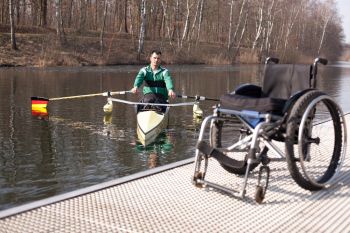
Para- rowing uses the same docks and courses as regular rowing events do. This sport has three types of events:
- Single Sculls– One rower, either male or female. There are no separate events for women and men. Para-rowers compete with men, women, and mixed teams.
- Double Sculls – Two rowers per boat. Again, this event can include male and female participants in the same boat.
- Coxed Four- This allows for four rowers plus the coxswain who will steer the boat and motivate the team.
Each event will be linked to the appropriate sports classes according to the impact of the athletes’ disability on performance.
For example, you will have a race for PR1 Singles, PR2 Singles, and PR3 singles. Then there are also races for Coxed four PR1 class, Coxed four PR2, etc. Side Note: Check out Rebecca’s great article on how to set up a Head Race Rowing Plan!
It’s interesting to note that the coxswain can be able-bodied. Since they aren’t actively rowing but are only controlling the direction of the boat and giving encouragement, it is not unusual to see an able-bodied coxswain at the head of a rowing crew.
Who Holds the World Rowing Championships?
Since rowing is greatly influenced by weather, Paralympic sports refer to World Best Times, rather than World Records.
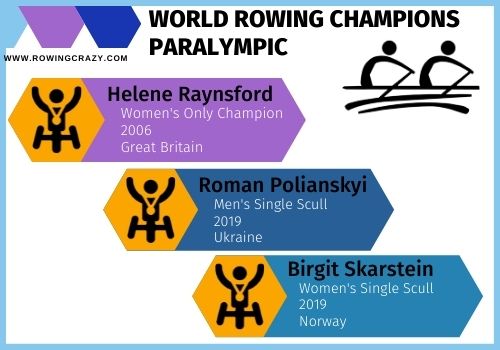
Tailwinds, water temperature, and currents can all affect a rower’s overall time.
- In 2006, there was a Women’s Only event held at the World Rowing Championships, and it was won by Helene Raynsford of Great Britain.
- Great Britain wins about 50 percent of all gold medals during Olympic and World rowing championships. As of this writing, anyway, because I’m sure Rowing Australia is going to take over this sport soon!
- In the 2019 World Rowing Championships, in the Men’s Single Scull division, Ukraine’s Roman Polianskyi holds the title with a time of 9:12.99.
- The holder of the Women’s Single Scull Division is Norway’s Birgit Skarstein at 10:16.33.
Personally, I think every one of these rowers are champions, regardless of their time.
- Click Here to Read Our Full Article on Master Rowing Issues & Frustrations
When Are the Next Paralympic Games?
Whenever and wherever there are Olympic games, the Paralympics commences immediately after the Olympics have concluded. The same venues are used and the races are held in the same host city.
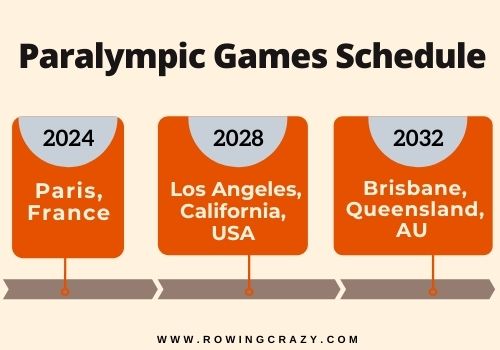
- In 2024, the Paralympics will be held in Paris, France.
- In 2028, the Paralympics will be held in Los Angeles, California, USA.
- In 2032, Brisbane, Queensland, Australia will have the honor of holding the summer Paralympic games.
Don’t you wish you could visit every single Olympic and Paralympic sporting event? What an exciting way to see the world!
Related Post: What is the difference between crew and rowing
The Bottom Line
At this time, 12 countries participate in the Paralympic games. Argentina, Australia, Austria, Belgium, France, Great Britain, Ireland, Israel, Italy, Netherlands, Switzerland, and the United States all train for and send para-athletes to summer games.
The paralympic sport was first held in Rome, Italy, in 1960. Back then, only athletes in wheelchairs were allowed to participate.
The sport has come so far since then! Today you will find paralympic athletes in power-lifting, horseback riding, archery, Judo, sailing, and many other events.
I find these athletes personally inspiring, and I hope you do, too. Let’s show our support by attending some of the local, state, and national championships when we can.
Be grateful always to be in this sport, folks! Let’s keep rocking and rowing!
Written by Petra Amara – RowingCrazy.com
CEO & Founder of RowingCrazy, National Rower, Coxswain Womens Eight Team, Rowing Coach & Writer
Petra is a Mother of two and owner of Rowingcrazy.com. Petra lives and breathes rowing, she also has a passion for writing which lead her to start RowingCrazy.com to share her rowing experience and expertise with others.



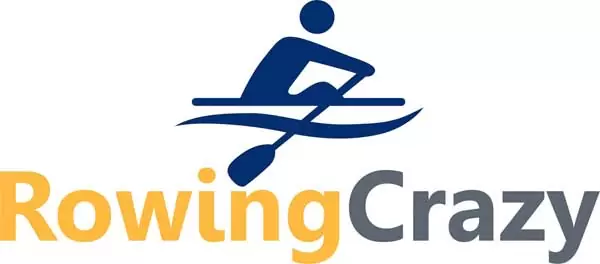


Pingback:
Pingback: